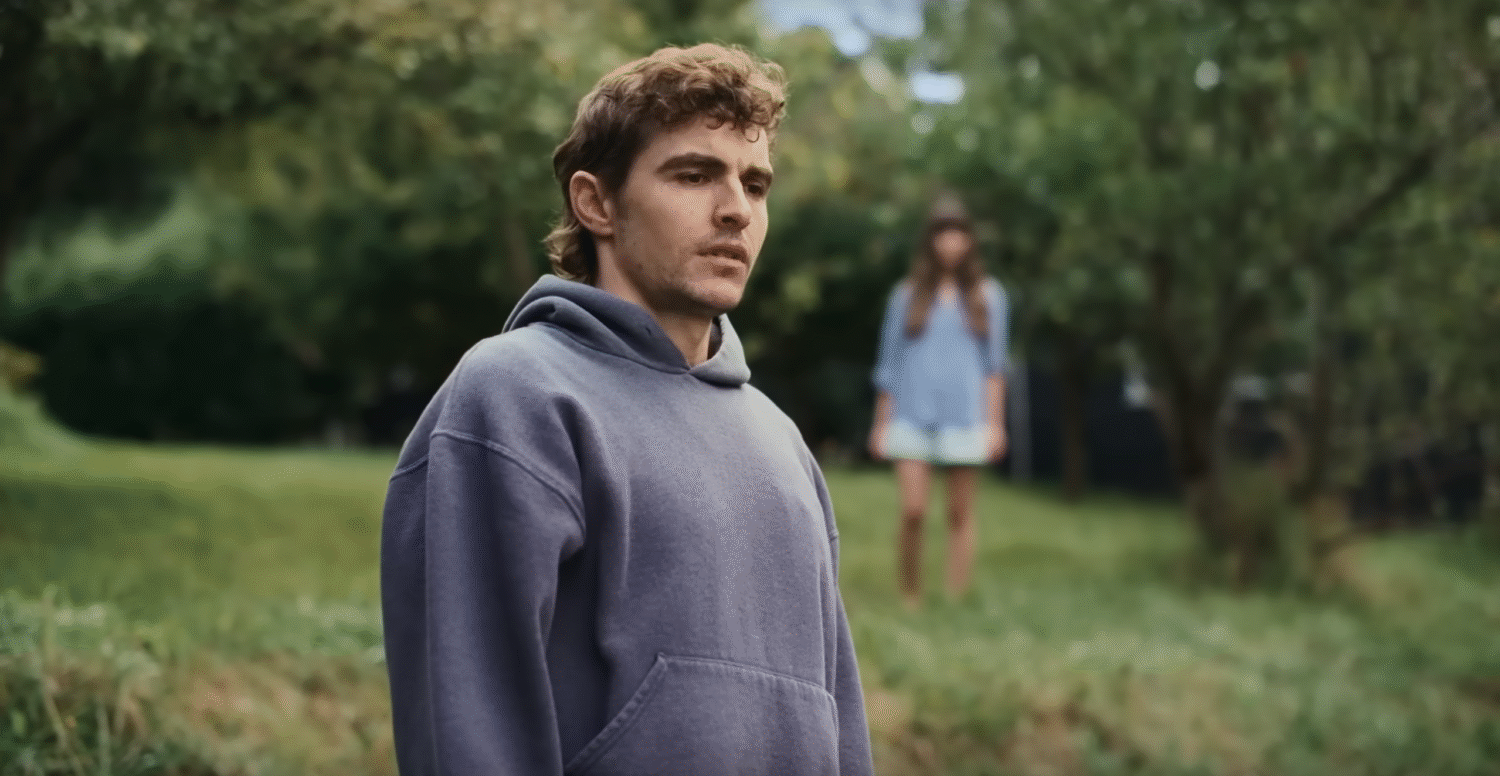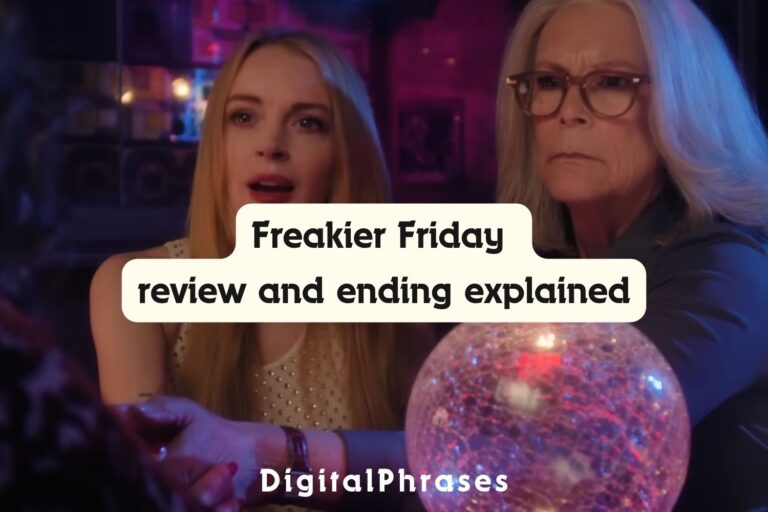Together (2025) Review and Ending Explained
Sometimes a movie comes along that takes a familiar idea—love, relationships, commitment—and stretches it into something so grotesque and surreal that you can’t look away. Michael Shanks’ Together, starring Alison Brie and Dave Franco, is exactly that. It’s part romance, part body horror, and part philosophical thought experiment that asks: what does it really mean to become one with someone?
Story Recap and Review
So, let’s start with the surface-level story—what actually happens—before peeling back the layers.
We open with a prologue that sets the tone: a search party combing the woods for a missing couple, while two dogs wander into an underground cave, drink from a strange pool, and then… begin fusing together.
Yes, fusing. Shanks isn’t here to ease us in—he wants us unsettled from the first reel. Body horror fans will immediately clock this as a callback to Cronenbergian transformations (The Fly comes to mind), but here the grotesque is paired with something oddly tender, almost romantic.

Enter Millie (Alison Brie), an elementary school teacher, and Tim (Dave Franco), a struggling musician. They’re moving out of the city to start fresh in the countryside. But right from the get-go, we see cracks.
At their going-away party, Millie proposes to Tim, and his hesitant, embarrassed reaction hangs like a storm cloud over everything that follows. It’s awkward, it’s human, and it’s the first sign that this film is just as much about relationship dynamics as it is about monsters.
Their relationship is tested further when, during a hike, they take shelter from a storm in that same cave from the prologue. Tim drinks from the pool, and the next morning they wake up with their legs literally stuck together.
Creepy?
Yes.
Symbolic?
Absolutely. The film keeps hammering home this idea of co-dependence versus autonomy. Tim and Millie can separate for now, but the pull toward fusion keeps coming back stronger.
This is where things get interesting, because the horror isn’t just in the gore—it’s in the way Shanks parallels physical fusion with emotional entanglement. Cinephiles will probably notice echoes of Andrzej Żuławski’s Possession (1981)—a domestic drama where a failing marriage manifests as literal monstrosity. Similarly, Together externalizes relationship struggles in grotesque physical ways.
Tim’s trauma adds another layer. We learn about his disturbing past—finding his mother in bed with his dead father’s corpse. That memory explains so much about his hesitancy toward intimacy and his fear of being trapped in another person’s orbit. His panic attacks, his resistance to Millie’s proposal, his general aloofness—they’re all tied back to this grotesque vision of love as decay.
Then comes Jamie (Damon Herriman), Millie’s co-worker, who at first seems like just a friendly neighbor but becomes the film’s philosophical anchor.
Over dinner, Jamie introduces Aristophanes’ myth from Plato’s Symposium: that humans were once whole beings, split by the gods, forever searching for their other half. It’s a clever move. Suddenly, this isn’t just about a freaky cave—it’s about the mythic roots of love itself.
From here, the body horror escalates. Genitals fuse during sex. Arms twist together in unnatural positions. Saw blades come out. And at every turn, Shanks ties these moments back to the question: when we commit to someone, are we completing ourselves—or destroying ourselves?
The missing couple, Simon and Keri, turn up in a horrifying state—half-fused, half-dead—a clear warning of what happens if you resist the process. Jamie, however, turns out to be the product of a successful fusion with his husband. He’s calm, serene, almost evangelical about the experience. In one chilling moment, he tells Millie and Tim that true happiness comes only after merging completely, shedding individuality. His calmness is as scary as the gore.
And then, of course, there’s the “rat story.”
Tim recalls how he once lived with a dead rat decomposing in his room, and he didn’t notice the smell until it was too late. It’s a brilliant metaphor for slow-burning toxicity in relationships. You acclimate to dysfunction until one day you can’t ignore it anymore. For me, that anecdote is one of the sharpest bits of writing in the whole movie—it’s grotesque, mundane, and metaphorical all at once.
Ending Explained
Now, let’s talk about that ending—because it’s wild, divisive, and absolutely loaded with meaning.
After multiple failed attempts to resist fusion, Tim decides he doesn’t want to end up like Simon and Keri. In a desperate, tragic gesture, he tries to slit his throat, effectively sacrificing himself so Millie won’t be trapped in this fate. Millie, meanwhile, is bleeding out from the wound Jamie inflicted on her earlier. In that moment, Tim makes a choice: instead of letting either of them die, he fuses his arm to her wound, completing the process.
They slow dance to the Spice Girls’ “2 Become 1” (a needle drop so on-the-nose it circles back around to being perfect) as they merge into one androgynous being. It’s grotesque, yes, but also—strangely—romantic. The film wants us to sit in that tension: the horror of losing yourself and the comfort of finally being whole.
And then comes the final gut punch. Millie’s parents arrive for a visit. They knock on the door, which now bears the cult’s symbol, and are greeted by a seemingly normal, androgynous figure. Not Tim, not Millie—something (or someone) else. The fusion is complete. The cult ideology, once resisted, has been fully embraced.
So what does it mean?
On one level, it’s a straight-up allegory about relationships and codependency. You can’t merge your life with someone else’s without losing something of yourself. The film dramatizes that loss in the most extreme way possible. Tim and Millie give up their independence, their individuality, their very bodies—to avoid loneliness, to avoid death, to avoid separation.
But here’s where Shanks adds nuance. The film shows us three outcomes:
- Simon and Keri: They resisted, and became a grotesque half-thing.
- Jamie: He embraced fusion fully, and found peace.
- Tim and Millie: They resisted, they fought, they suffered, but in the end, they chose fusion as an act of love.
The question is, did they really choose—or was it inevitable? That’s where the film leaves you hanging. The cult imagery at the end suggests that once you drink from the pool, your fate is sealed. Resistance only prolongs the suffering.
There’s also a fascinating gender element here. The final fused being is androgynous, nodding to Aristophanes’ myth of the “third sex.” In Greek thought, love isn’t just about union, but about transcending binaries—male/female, self/other. Shanks seems to be suggesting that love, at its extreme, dissolves all categories. It’s not about two halves making a whole, but about creating something entirely new.
And that’s both beautiful and terrifying.
For cinephiles, it’s hard not to compare this to Cronenberg’s The Fly, where love persists even as bodies rot and mutate, or Jonathan Glazer’s Under the Skin, where the alien and the human can never truly merge. Together asks: what if merging was possible? What if the cost of intimacy was total obliteration of self?
Personally, I think the ending works because it doesn’t settle on one clean answer. On one hand, Tim and Millie’s fusion is an act of ultimate love—they literally can’t live without each other. On the other, it’s horrifying—they’ve lost everything that made them individuals. Shanks traps us in that paradox, and that’s why the film sticks with you long after the credits roll.
Together is messy, weird, and occasionally over-the-top, but that’s what makes it so fascinating. It’s not just another horror film—it’s a relationship drama in grotesque disguise. By using body horror as metaphor, Shanks forces us to think about what it really means to bind your life to another person’s.
The ending doesn’t offer comfort—it offers questions. Are we meant to see Tim and Millie’s fate as tragic or beautiful?
Is the cult right, or is their “harmony” just another form of death? And maybe most importantly: when we talk about finding our “other half,” do we really know what we’re wishing for?
For me, Together sits alongside films like Possession, The Fly, and even Ari Aster’s Midsommar as a horror film that dares to make love scarier than death. And honestly?
That’s the kind of horror I find most compelling—the kind that makes you look at your own relationships and wonder what you might be willing to give up… or fuse with.






